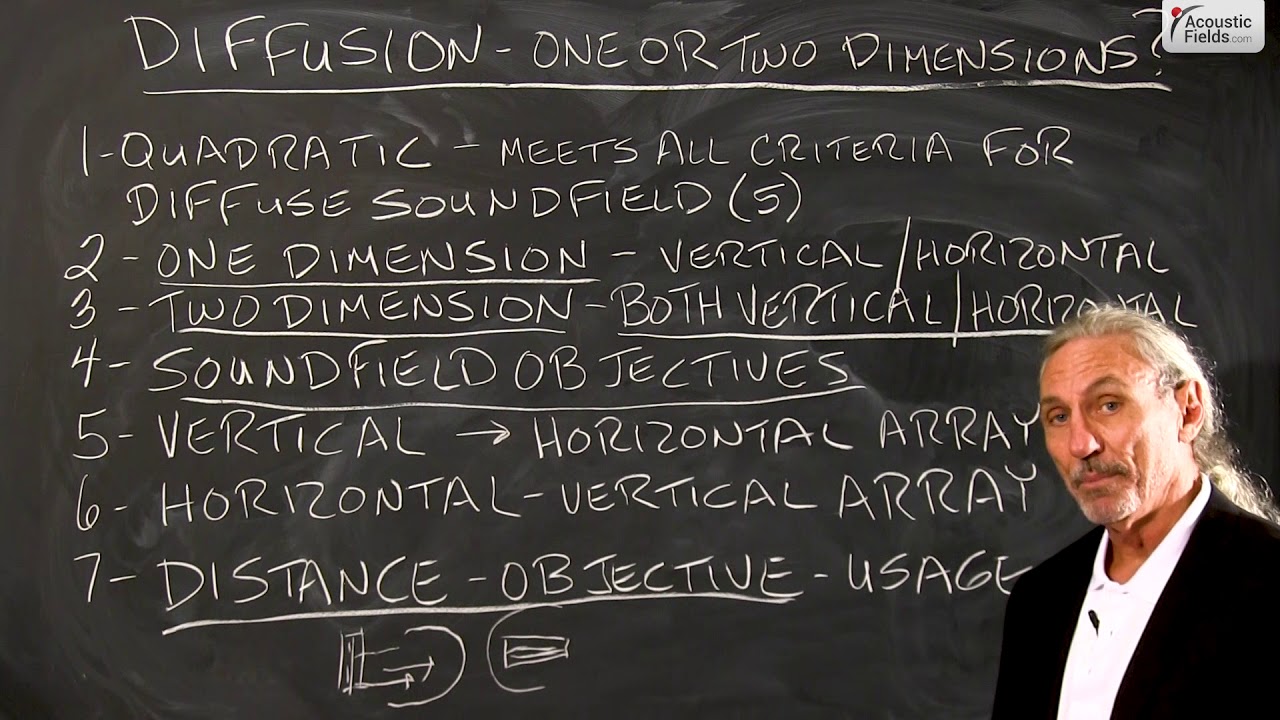Let’s talk about diffusion and we all know from my past videos and my room designs that I’m big on quadratic. Quadratic is the only diffusion that I have found that satisfies all the 5 criteria for a real, true, diffuse sound field. Now in a room we know we have 3 real major sound fields. We have the horizontal, we have the vertical and then we have front to back.
So we really have 3 sound fields in a room that must be conscious of. And we know from past videos that a one dimensional diffusion, if we take a diffuser and we position it vertically, we know that our distribution of the energy is in a horizontal array. So if we take our diffuser and we put it horizontally we know that then our diffusion is more in a vertical array.
So the actual physical positioning of the diffuser determines the distribution of the energy. And we really need to think of a diffuser as a speaker. It’s not something we plug in, it doesn’t have a moving diaphragm to generate energy but the energy that goes into it and then comes back out, does act like a diffuser. So when we’re after two dimensions of diffusion we take both vertical and horizontal positioning. And that gives us two dimensions of diffusion. So it gives us a vertical and a horizontal array.
Now, when do we use that? Because you see in a lot of our designs you’ll see just vertical diffusion, in some cases you’ll see horizontal so it just depends on what your objectives are in the room, what are you trying to accomplish? So here’s the thing about diffusion. It’s so distance-dependent. So no matter what you’re doing, a vertical or a horizontal distribution, no matter what you’re doing with the diffuser, distance is the key. Why? Because the energy that goes into the diffuser and then comes out, must have the appropriate distance to fully form and mature.
So depending on the diffuser and sequence and the depth of the diffuser, certain distance requirements we have to have. So when we don’t have enough distance for vertical or strictly horizontal one-dimensional diffusion we can look to two-dimensions. And the thing about two-dimensional diffusion; it will work within distances that we cannot use for vertical and horizontal one dimensional diffusion.
So it all depends on what we’re trying to do in the room, the usage and the objectives of the room. So the thing about vertical and horizontal diffusion by itself, definition, separation, air, okay? When we’re doing two dimensional diffusion in a room, it’s all about minimizing reflections and not localizing the distance. So we’re trying with two-dimensions to get the surface area to disappear. I call that psycho-acoustic space. We’re going to do a video on that coming up.
So bottom line, if you have the room for vertical or horizontal diffusion and your objectives are definition and separation and air then we’re in good shape. If you don’t have that distance but still want the non-localization that you get with diffusion we can look at two dimensions of diffusion. And I can determine that when you submit your room form. So I hope this helps clarify the diffusion issue that I see a lot.
—
This is an unedited transcript from our video series from Acoustic Fields. There will be some errors in grammar and sentence structure that occur during this translation process.
For complete understanding and comprehension, please view the video which is included in this text. For any additional information regarding this topic or others relating to room acoustics, please contact us directly at:
P: 520 – 392 – 9486








If I need to submit my room details and subscribe, that’s fine will do. My listening room is 13×19. I Am satisfied with my DIY efforts so far with bass traps and resonator between speakers. Ceiling and rear wall are good. My only dilemma sees to be how to optimize side wall first and second reflection points. Can you advise on best detail imaging between speakers as to what side wall diffusers would optimize the sound experience?
We prefer one dimensional for front and rear walls for two channel set ups. We use absorption for sidewall reflections. Do not use building insulation in your DIY projects. It destroys harmonics.